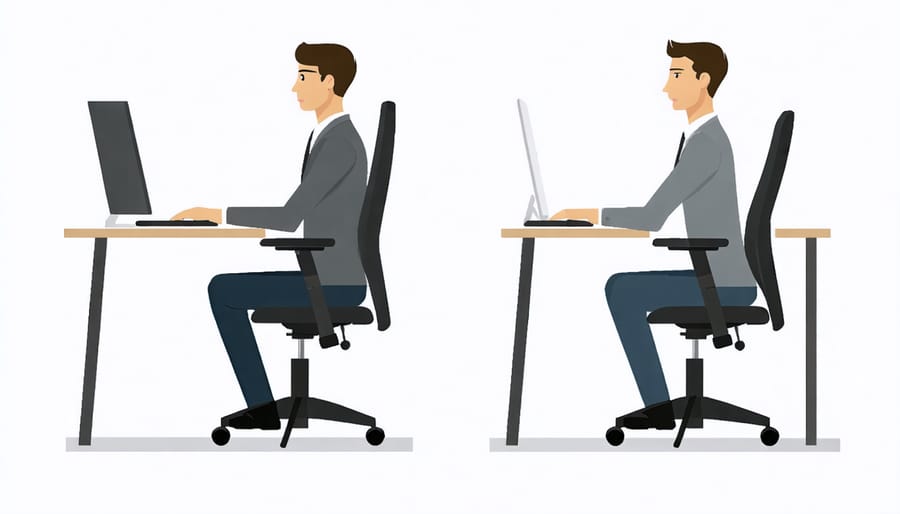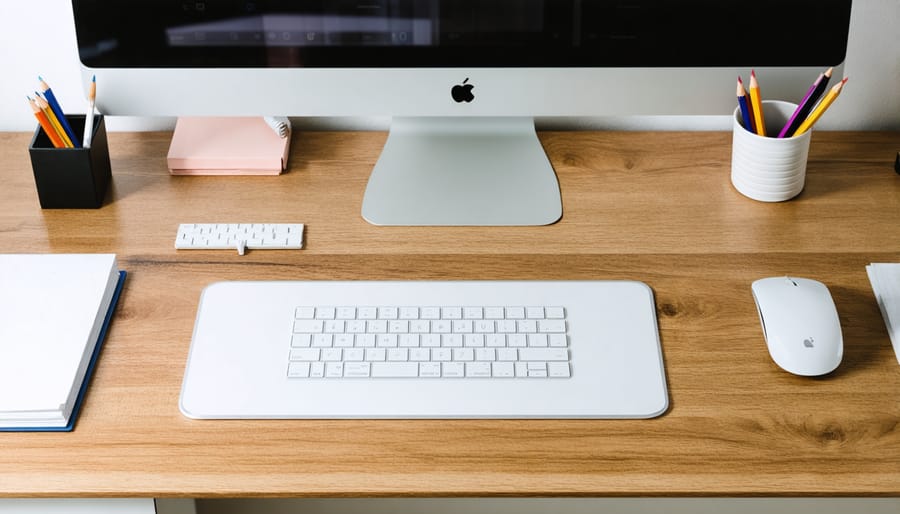Choose an adjustable desk that allows sitting and standing to promote healthy posture and reduce sedentary behavior. Invest in an ergonomic chair with lumbar support, armrests, and adjustable height to minimize back strain and improve comfort. Design the perfect workspace by optimizing lighting with a mix of natural and task lighting to reduce eye strain and enhance focus. Organize your desk with designated zones for essential items, utilizing desk organizers, cable management solutions, and storage to maintain a clutter-free environment that boosts productivity.
Choose the Right Desk

Desk Size and Shape
When selecting a desk, consider the available space and your working style. A rectangular desk is a classic choice that fits well in most rooms, while an L-shaped or U-shaped desk provides extra surface area and storage if you have the space. For smaller areas, a corner desk can maximize limited square footage. Aim for a desk that’s at least 48 inches wide and 24 inches deep to accommodate your computer, peripherals, and other essentials comfortably. Adjustable height desks allow you to alternate between sitting and standing throughout the day, promoting better posture and reducing the negative effects of prolonged sitting.
Desk Materials and Features
When selecting a desk, consider materials like wood, metal, or glass, and ensure it’s sturdy and spacious enough for your needs. Look for built-in storage options such as drawers, shelves, or a hutch to keep your workspace organized and clutter-free. If you have limited space, opt for a desk with vertical storage or a fold-down design. Adjustable features are crucial for ergonomics and comfort. A height-adjustable desk allows you to alternate between sitting and standing positions throughout the day, reducing strain on your back and neck. Additionally, an adjustable keyboard tray and monitor arm can help you maintain proper posture and minimize eye strain. When choosing a desk chair, prioritize adjustable height, armrests, and lumbar support to ensure optimal comfort during long work sessions. Remember to select materials and features that suit your personal style and complement your home office decor.
Invest in a Comfortable Chair
Investing in a comfortable, supportive chair is crucial for maintaining good posture and reducing fatigue during long hours at your work desk. Look for a chair with adjustable features such as seat height, armrest position, and lumbar support to ensure a customized fit for your body. Ergonomic chairs are designed to promote proper alignment of your spine, neck, and shoulders, which can help prevent strain and discomfort. Consider chairs with breathable materials like mesh or high-quality fabric to keep you cool and comfortable throughout the day. Memory foam or contoured seat cushions can provide additional support and pressure relief. Remember, a comfortable chair is an investment in your well-being and productivity, so take the time to find one that suits your needs and budget. Don’t hesitate to test out different options and read reviews before making a decision. Your back and body will thank you for prioritizing comfort and ergonomics in your work desk setup.

Optimize Monitor Placement
Proper monitor placement is crucial for maintaining good posture and reducing eye strain. Position your monitor directly in front of you, centered with your body, at a comfortable viewing distance of about an arm’s length away. The top of the screen should be at or slightly below eye level, allowing you to keep your neck in a neutral position while working. Tilt the monitor back slightly, around 10-20 degrees, to minimize glare and prevent neck strain from looking upward. If using multiple monitors, place your primary screen directly in front of you and secondary screens to the side at the same height and distance. Adjust the monitor’s brightness and contrast settings to reduce eye fatigue, and consider using an anti-glare filter if necessary. Remember to take regular breaks and look away from the screen every 20 minutes to give your eyes a rest. By optimizing your monitor placement, you can create a more comfortable and ergonomic workspace that promotes better posture and reduces the risk of neck and eye strain.

Incorporate Ergonomic Accessories
Investing in ergonomic accessories can make a world of difference when it comes to your comfort and productivity at your work desk. Consider adding a wrist rest to your setup, which helps maintain a neutral wrist position while typing, reducing strain and preventing conditions like carpal tunnel syndrome. A supportive mouse pad with a built-in wrist rest can also provide cushioning and promote proper alignment during long hours of computer work.
To minimize neck strain and eye fatigue, a document holder is a must-have accessory. By placing your documents at eye level and close to your monitor, you can maintain a healthy posture and reduce the need for constant head and neck movements. Look for adjustable holders that can accommodate various paper sizes and allow for easy viewing.
An ergonomic footrest is another valuable addition, especially if your desk height isn’t adjustable. It helps keep your feet supported and promotes better circulation, preventing discomfort and fatigue in your legs and feet. Choose a footrest with a non-slip surface and adjustable height to customize it to your needs.
Lastly, don’t forget about your back support. An ergonomic chair with lumbar support is crucial, but you can enhance its effectiveness with a separate lumbar cushion. This accessory helps maintain the natural curvature of your spine, reducing pressure on your lower back and promoting a healthier sitting posture. By incorporating these ergonomic accessories into your work desk setup, you’ll create a more comfortable and efficient workspace that supports your well-being and productivity.
Manage Cables and Cords
Taming the tangle of cables and cords is crucial for maintaining a clutter-free desk surface. Start by identifying which cables you use frequently and which ones can be tucked away. Use cable ties, velcro straps, or reusable cable wraps to bundle cables together neatly. Label each cable to avoid confusion when plugging in devices.
Consider investing in a cable management box or tray that can be mounted under your desk to conceal power strips and excess cable lengths. For a more budget-friendly solution, repurpose a shoebox or small basket to store cables and keep them out of sight.
If your desk has a grommet hole, thread cables through it for a cleaner look. Alternatively, use adhesive cable clips to run cables along the back or underside of your desk, keeping them organized and off the floor.
For cables that must remain on your desk, like phone chargers or USB cables, opt for sleek cable organizers that blend in with your desk decor. Some organizers even come with built-in wireless charging pads, streamlining your charging needs.
Remember, a little cable management goes a long way in creating a visually appealing and functional workspace that promotes focus and productivity.
Add Personal Touches
Adding personal touches to your work desk can make a world of difference in boosting your mood and productivity. Consider incorporating elements that inspire you and bring joy to your workspace. One simple way to liven up your desk is by adding a small plant or succulent. Not only do plants add a pop of color and freshness, but they also help purify the air and create a calming atmosphere. Another great idea is to display photos of your loved ones, favorite memories, or inspiring quotes that motivate you throughout the day. You can personalize their desk further with decorative items that reflect your personality and style, such as a unique desk lamp, a stylish pen holder, or a fun mousepad. By surrounding yourself with things that make you happy and inspired, you’ll create a work environment that feels more inviting and enjoyable, ultimately leading to increased motivation and productivity. Remember, a well-personalized desk can make even the most challenging workdays feel a little brighter, so don’t hesitate to add those special touches that make your workspace uniquely yours.
Conclusion
Setting up an ergonomic and well-organized workspace at home is essential for boosting productivity, maintaining focus, and promoting overall well-being while working remotely. By selecting the right desk, prioritizing proper posture and comfort, keeping your space tidy and organized, and adding personal touches, you can create a functional and inviting environment that encourages efficiency and motivation. Remember, investing time and effort into optimizing your home office setup will pay off in the long run, helping you stay comfortable, focused, and successful in your work-from-home endeavors. Embrace the opportunity to create a space that truly works for you, and enjoy the benefits of a well-designed and personalized work desk.
